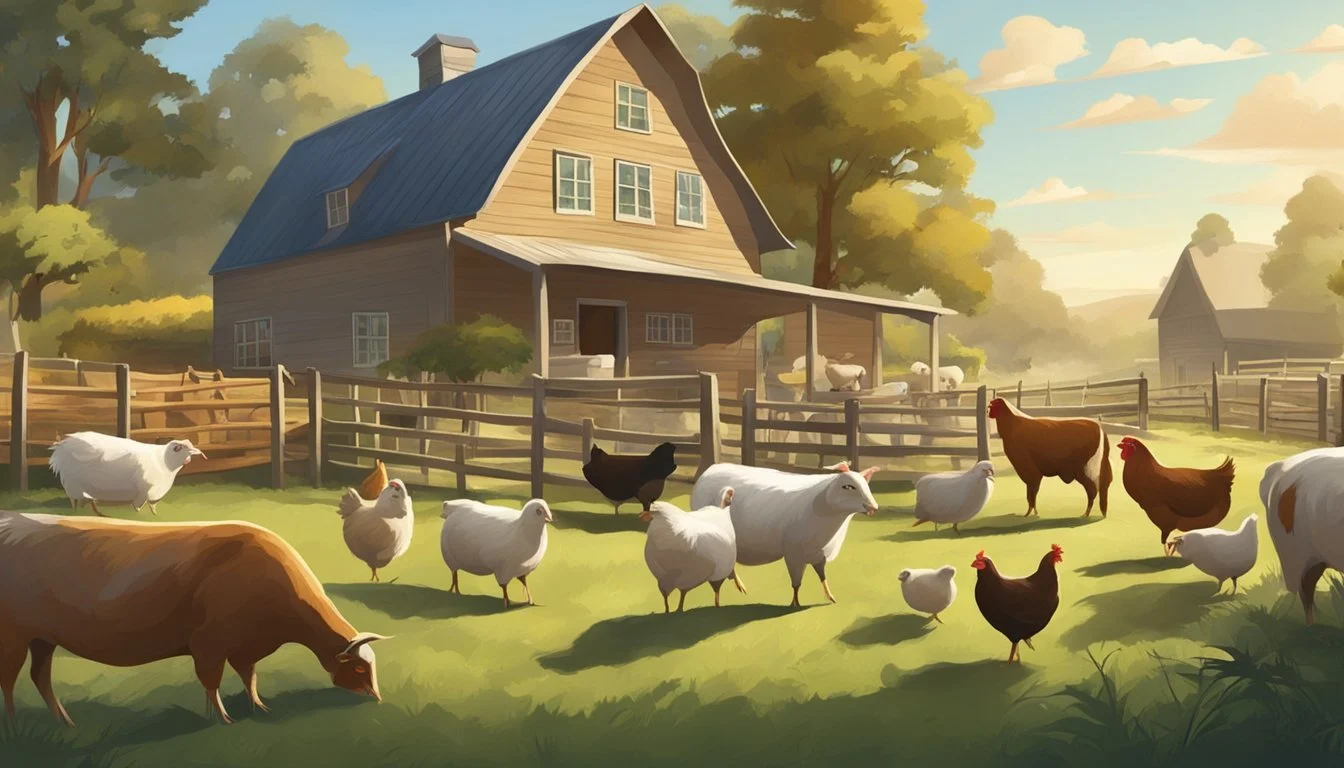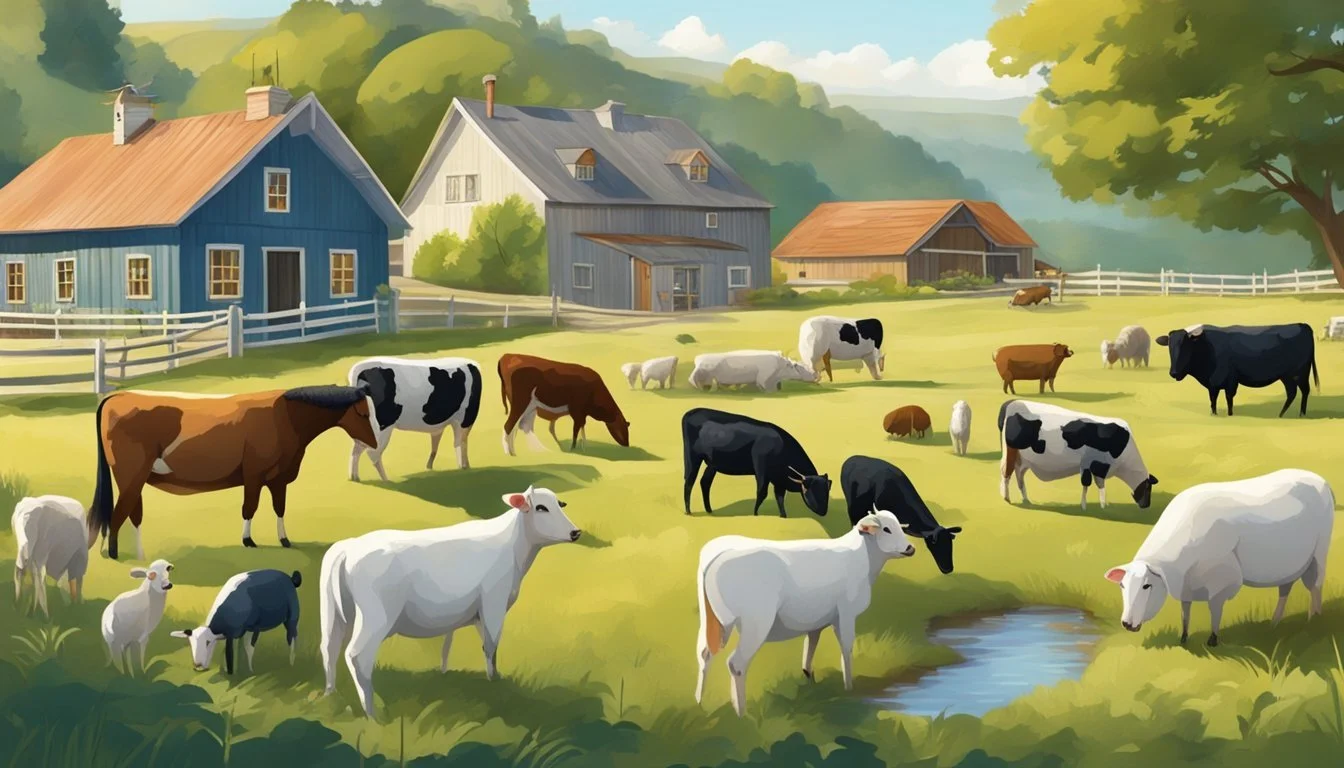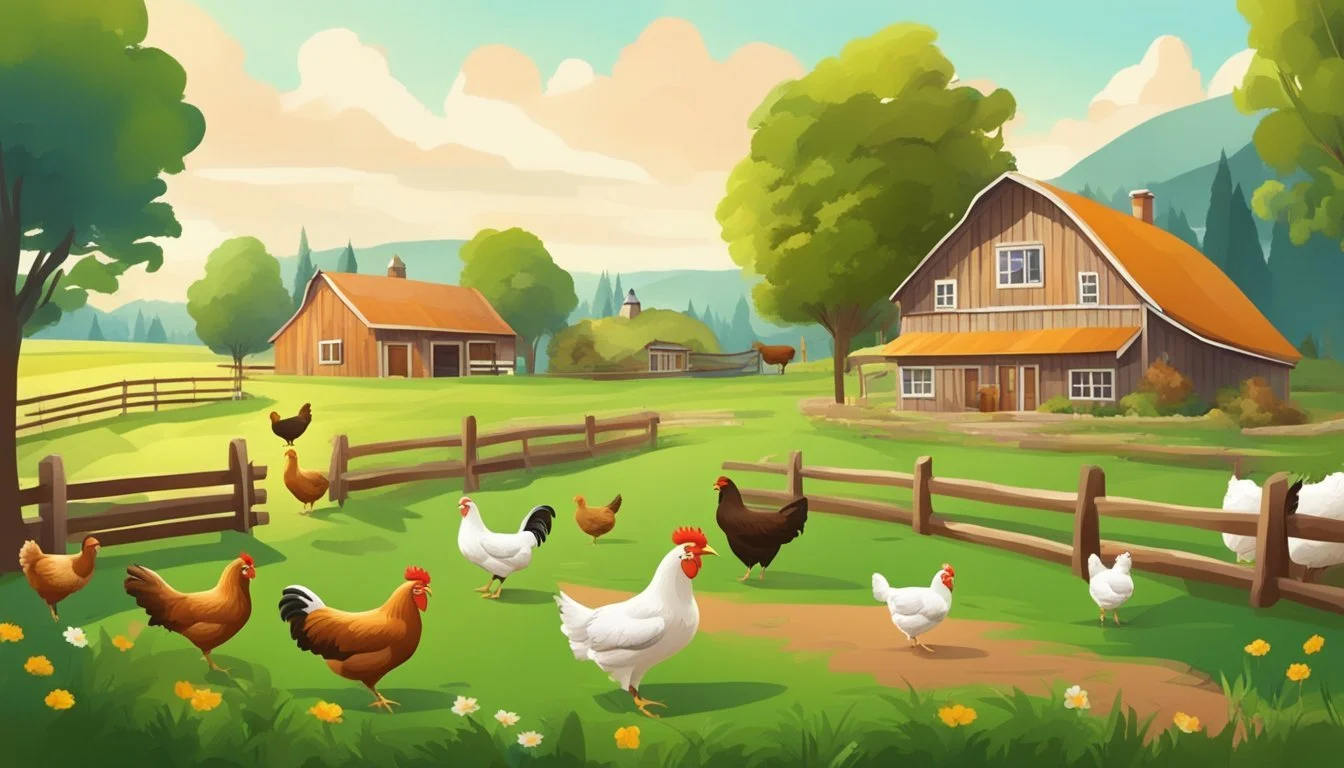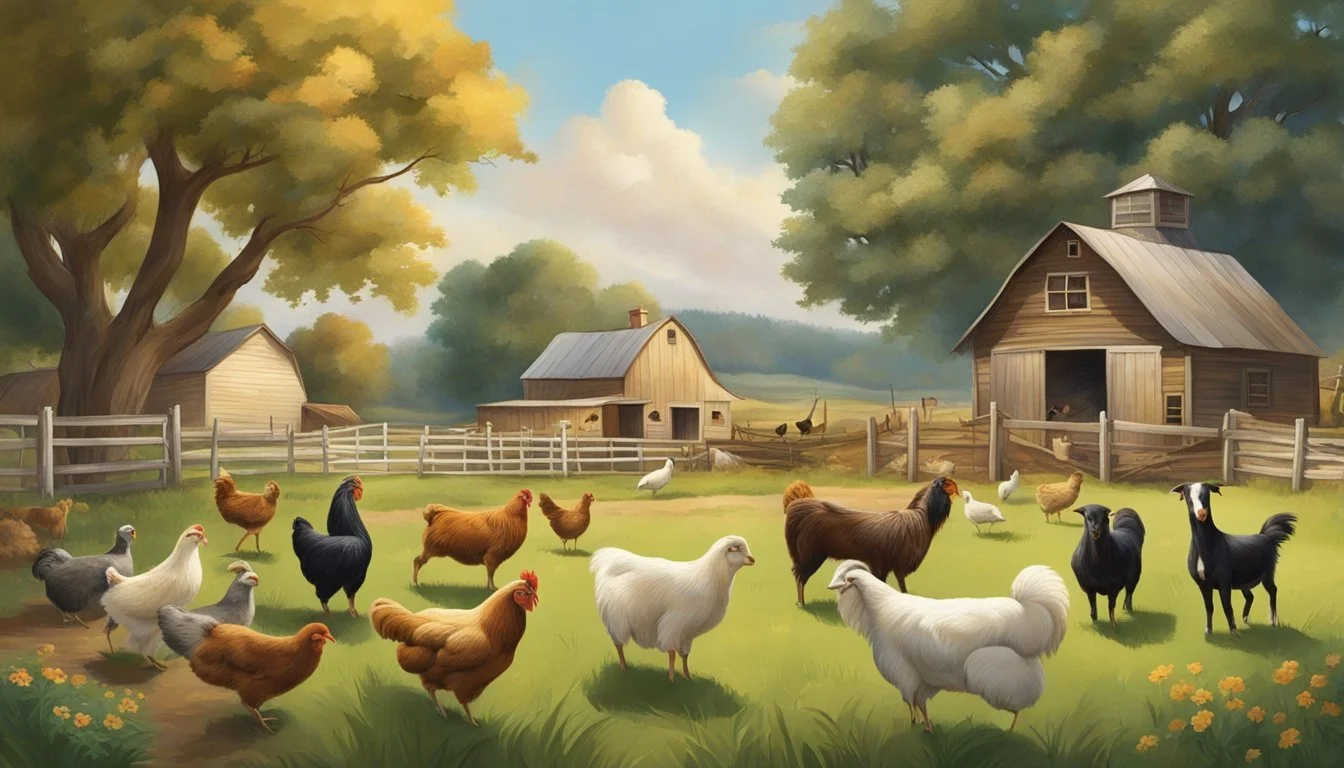Homestead Livestock
Best Breeds for Small Farms Essentials
Embarking on the journey of maintaining a homestead requires consideration of what livestock to raise. For small farms, certain breeds stand out for their manageability, efficiency, and compatibility with limited space. These breeds offer a range of benefits, from providing food to contributing to farm work, and have been adapted over time to thrive in more compact farm settings.
Selecting the right livestock is critical to the sustainability and productivity of a small farm. Miniature cattle breeds, for instance, such as Miniature Cows, are prized for their smaller stature, which requires less pasture and feed. Pygmy goats, on the other hand, are not only a source of milk but also serve as friendly and manageable farm companions, well-suited to smaller parcels of land.
A small farm can benefit significantly from choosing the appropriate livestock, taking into account the size of the breed, the nature of its care and feeding requirements, and its adaptability to the land available. It is evident that homesteaders have a variety of options available to them, from dairy goats in miniature to the hardy and resourceful Highland cattle. The key is to identify breeds that not only fit their space but also align with their farming goals and lifestyle.
Selecting Suitable Breeds for Your Homestead
Selecting the right livestock breeds for a homestead involves thorough consideration of environmental conditions and the farm's specific characteristics. These factors ultimately determine the breeds that can thrive and fulfill their intended roles on a small farm.
Assessing Your Environment and Climate
When choosing livestock, the local climate plays a pivotal role. Breeds must tolerate regional temperatures, precipitation levels, and extreme weather events. For instance, the Spanish, San Clamente, and Oberhalsi are breeds that various homesteaders have successfully incorporated into their operations due to their adaptability to certain environments. Farmers should research breeds' origins to gauge their suitability for local climate conditions.
Understanding Space and Acreage Limitations
Small farms are often limited by the amount of land available. It's crucial to select breeds that can flourish in confined spaces and don't overtax limited forage resources. Breeds have different space requirements, with some cattle breeds needing more acreage than others. For instance, the Beefmaster cattle breed is noted for its adaptability but requires sufficient land to roam, which may not be suitable for smaller acreages.
Importance of Breed Hardiness and Care Requirements
Hardiness and care needs are significant factors. Homesteaders should opt for breeds known for their resilience to disease and minimal care necessities. Hardier breeds usually fare better in variable conditions and require fewer resources, making them ideal for small farms with limited resources. Understanding the care and feeding of chosen livestock is essential for their health and the homestead's productivity. For example, certain sheep breeds are favored by small property owners for their lower maintenance needs and adaptability.
Best Breeds for Meat Production
Choosing the right livestock breeds for meat production on small farms hinges upon understanding their size, growth rate, and meat quality. Knowing which breeds excel in these areas can lead to a successful and sustainable meat production operation.
Cattle for High-Quality Beef
Dexter cattle are renowned for their versatile use in both milk and meat production. They are smaller in stature, yet their meat is known for being tender and flavorful. For those with limited pastureland, Dexter cattle are efficient grazers and can be raised on marginal lands.
Miniature cattle breeds, such as Miniature Herefords and Lowline Angus, are also well-suited for small farms. Their compact size allows for more efficient management, and these breeds provide high-quality beef with less feed consumption when compared to larger cattle breeds.
Small-Scale Poultry for Lean Meat
For poultry, broiler chickens are specific strains bred for their fast growth and substantial lean meat yield. Their rapid development rate makes them a preferred breed for efficient meat production, as they are usually ready for processing around 6-8 weeks of age.
Additionally, the American Guinea Hog is an excellent poultry choice for its lean meat. This breed is smaller than commercial pigs, adapts well to pastures, and can effectively forage, reducing feed costs.
Raising Goats and Sheep for Meat
When it comes to goats, the Boer goat is a standout breed for meat production due to its fast growth rate and high-quality meat. This breed has been specifically developed for meat and possesses a high feed-to-meat conversion ratio, making it a prime choice for efficient breeding.
For sheep, breeds such as the Cheviot Sheep are celebrated for their hardiness and excellent meat. These sheep thrive in various climates and terrain, with a strong flocking instinct, making them easier to manage, which is ideal for small-scale farming operations. Their meat is prized for its lean quality and flavorful taste, marking them as an excellent breed for artisanal meat producers.
Dairy Breeds for Small Farms
When considering dairy production on a small farm, selecting the right breed is crucial for efficiency and yield. Key factors include the animal's milk production capacity, adaptability to smaller land areas, and the quality of dairy products such as milk and cheese that they can produce.
Cow Breeds for Milk and Cheese Production
For small-scale dairy production, Dexter cattle are highly recommended. They are a versatile breed, providing up to three gallons of milk per day, which is ideal for both drinking and cheese-making. Another great option is the Milking Devon, known for its high-quality beef and milk production on minimal forage, this cow often produces milk with around 4 percent butterfat, suitable for rich dairy products.
Dexter Cattle: Three uses: dairy, beef, draft
Milk Production: Up to 3 gallons/day
Butterfat Content: Ideal for cheese
Milking Devon: Good beef and dairy on marginal forage
Milk Quality: High butterfat (~4%)
Goat Breeds for Dairy Products
Among goats, the Nigerian Dwarf breed is a standout for small farms—they produce a sweet-tasting milk with a high butterfat content, which is perfect for artisanal cheese production. Adult does can produce between half to two gallons of milk per day, making them a prolific source of dairy despite their small size.
Nigerian Dwarf Goat: High butterfat milk, sweet taste
Milk Production: 0.5–2 gallons/day
Size: Petite, adaptable to smaller spaces
Another excellent breed for dairy production is the Miniature Silky Fainting goat, known for its quality milk and unique appearance, though less commonly used than the Nigerian Dwarf.
Sheep and Other Animals for Specialty Dairy
While less common, certain breeds of sheep provide niche dairy products for small-scale farming. East Friesian sheep are recognized for their high milk yields and are often farmed for specialty cheeses and yogurts.
For farms interested in more unique dairy products, animals such as the Miniature Jersey and the Guernsey cow offer high-quality milk with a distinctive flavor profile, although they may require more space and management compared to smaller breeds.
East Friesian Sheep: Specialty cheese and yogurt
Milk Production: High Yield
When selecting dairy breeds for a small farm, it is essential to balance milk production capabilities with available space and the specific dairy products you wish to produce. Dexter cattle, Nigerian Dwarf goats, and East Friesian sheep are all excellent choices to consider.
Fiber and Wool Producing Livestock
For small-scale farmers and homesteaders, choosing livestock that produce quality wool and fiber can be both rewarding and profitable. The right breeds can offer diverse products ranging from soft wool for the textile market to unique fibers for niche crafts.
Sheep Breeds with Quality Wool
Jacob Sheep: Known for their distinctive spotted fleece, Jacob Sheep produce a medium-quality wool that is coveted for hand-spinning. Their wool typically features a blend of light and dark fibers, which can be separated or spun together for a naturally patterned yarn.
Shetland Sheep: This breed is famous for its fine fleeces, which are soft and available in a variety of colors. Shetland Sheep wool is a popular choice for delicate knitting projects and can be used to make high-quality garments.
Babydoll Southdown Sheep: They are prized for their fine, medium-length wool, which is elastic, dense, and has a micron count that contributes to its characteristic softness. It's an excellent choice for cozy apparel and is often sought after by handspinners.
Harlequin Sheep: A more recent breed, Harlequin Sheep are valued for their soft and luxurious wool. Their unique coat, which has a double layer—a fine soft undercoat and a longer, coarser outer coat—makes it versatile for various wool products.
Other Fiber-Producing Animals
Beyond sheep, several other animals produce valuable fibers for textiles and crafts. Alpacas and Angora rabbits, for instance, are renowned for their ultra-soft and warm fibers. Alpaca fiber is hypoallergenic and comes in a range of natural colors, while Angora wool is extremely light and fluffy, perfect for high-end luxury items. These animals can be an excellent addition to a small farm looking to diversify its fiber production.
Multipurpose Animals for Diversified Homesteads
Selecting the right breeds is crucial for a homestead that aims to maximize the potential of its livestock. Multipurpose animals that provide various resources like food and companionship, while being cost-effective, are integral for small-scale sustainability.
Dual-Purpose Cattle for Beef and Milk
Dwarf Nubian and Miniature cattle breeds emerge as prime choices for small farms where both dairy and beef are desired. Dwarf Nubians excel as both milk producers and companions. Miniature cattle breeds, like the Miniature Hereford, can efficiently convert forage into quality milk and beef, making them a profitable addition.
Chickens and Ducks for Eggs and Meat
Chickens such as Bantams are smaller birds that offer an ample supply of eggs, with the added benefit of being excellent mothers. They suit smaller spaces well and can also provide meat. Ducks add variety to a homestead's produce while also controlling pests and weeds, serving as both producers and pets.
Small Breeds Serving as Pets and Producers
Pygmy goats stand out as social, compact animals that contribute to a homestead's output through their milk and their ability to thrive in smaller pastures. They, along with other miniature breeds, adapt well to various environments and can double as friendly pets.
Management of Pasture and Foraging
Effective pasture management and foraging are critical for the success of small-scale farming, ensuring a high-quality, sustainable food source for livestock, which includes hardy breeds like Highland cattle.
Optimizing Pasture for Livestock Grazing
Optimizing pasture involves a balance between forage availability and animal needs, adhering to a system that supports the health and productivity of the pasture. Small farms should plan production and marketing to maintain a year-round forage supply, acknowledging that pasture is the most cost-effective feed source. They should implement rotational grazing, allowing forage to recover, which in turn supports free-range feeding practices and reduces the need for supplementary feed. Regular soil testing, overseeding with high-quality forage varieties, and using manure effectively as a fertilizer contributes to a low-input, profitable pasture system.
Implementing Effective Foraging Strategies
Foraging strategies are tailored to maximize the efficient use of available forage throughout the year. This includes identifying and cultivating hardy breeds that can thrive on the forage that is indigenous to the region. Highland cattle, for example, are a hardy breed known for their ability to forage on rough terrain. Adjusting stocking rates to avoid overgrazing and aligning livestock feeding habits with forage growth cycles are crucial tactics. One must not overlook the implementation of proper manure management to recycle nutrients, essentially turning waste into a valuable resource to bolster soil fertility and forage health. Integrating foragers, such as chickens, can also help manage pests and distribute manure evenly. The objective is always to maintain a sustainable system that supports low-input operations while remaining profitable.
Sustainable Practices in Livestock Farming
Sustainable practices in livestock farming are essential for the health of animals and the environment. They encompass everything from the breeds chosen to the management of waste and integration with crops.
Organic and Low-Impact Farming Techniques
Organic farming involves raising livestock without synthetic fertilizers, pesticides, and genetically modified organisms, thereby prioritizing the use of natural solutions for disease resistance and feed. This method supports environmental health and animal welfare. Selecting disease-resistant breeds and practicing rotational grazing are foundational low-impact techniques that contribute to sustainable livestock farming.
Manure Management and Soil Fertility
Effective manure management is crucial in transforming waste into a resource. By composting manure, farmers can produce organic fertilizer, which can enhance soil fertility and reduce the reliance on chemical fertilizers. Farmers also implement practices to prevent nutrient runoff, thereby protecting water quality and promoting efficiency in nutrient cycling.
Integrating Livestock with Crop Production
Integrating livestock with crop production provides several ecological benefits. Livestock can graze on crop residues, turning potential waste into valuable hay, which in turn reduces feed costs. This integration also allows the manure from livestock to serve directly as a fertilizer for crops, thereby creating a closed-loop system that reduces external inputs and enhances overall farm efficiency.
Equipment and Infrastructure for Animal Care
Proper equipment and infrastructure are crucial for the welfare and management of livestock on a small farm. These components also contribute to efficient daily operations.
Essential Fencing and Housing
Fencing is imperative for the safety and containment of livestock. It prevents animals from straying and protects them from predators. For example, electric fencing is effective for larger animals such as cattle, while woven wire fencing may be better suited for sheep and goats. Proper gates and secure latches also form a critical part of the fencing system to ensure ease of access while preventing escape.
Housing shelters animals from adverse weather conditions and provides a space for rest and feeding. Structures should be well-ventilated, dry, and suited to the specific needs of the animals. For instance, chickens require coops with nesting boxes and perches, whereas livestock like goats need draft-free, bedded barns to protect them from cold weather.
Feeding Equipment and Storage Solutions
Proper feeding equipment such as troughs, feeders, and water dispensers ensure animals have constant access to fresh food and water. The durability and design of these tools should match the animal's size and feeding behaviors. Automatic waterers can save time and ensure a clean water supply.
Adequate storage solutions are essential for preserving feed and protecting it from moisture and pests. Silos and feed bins are common storage units that keep large quantities of feed fresh and dry. Manure management tools, like manure spreaders or composting systems, are vital for handling waste efficiently, reducing odors, and maintaining cleanliness.
Creating a well-designed space with proper equipment is key for successful small-scale farming, helping to promote the health and productivity of homestead livestock.
Alternative and Niche Livestock
For small-scale farmers and homesteaders seeking to maximize their land's productivity, there's great value in exploring alternative and niche livestock. These choices often require less space, may be more sustainable, and can cater to special markets or personal preferences.
Unconventional Meat Sources Like Rabbits and Game Birds
Rabbits are an efficient meat source for small farms due to their rapid reproduction rate and limited space requirements. Their meat is a sustainable option, appreciated for its high protein and low-fat qualities.
Game birds such as quails and pheasants are becoming increasingly popular on small farms. These birds offer unique flavors and are well-suited to smaller spaces, satisfying the demand for speciality meats.
Unique Dairy Animals Beyond Cows and Goats
Beyond the common dairy cows and goats, Dexter cattle are a versatile option for dairy and beef. Originating from the south of Ireland, they are small but hardy, making them suitable for cheese-making on small homesteads.
Zebu, a breed adapted to harsh climates, offer an alternative dairy source. Though less common, Zebu cattle are noted for their high butterfat content, a bonus for artisan dairy products.
Rare Breeds and Heritage Livestock
Heritage livestock maintain genetic diversity and can adapt to local environments. Belted Galloways, originating from Scotland, are a hardy beef breed known for their distinctive white belt and are well-suited to wet climates.
Scottish Highland cattle are another robust breed known for their long horns and thick coats, enabling them to thrive in harsh Scottish conditions.
American Guinea hogs, smaller than standard pig breeds, are highly efficient grazers, making them a practical option for small-scale sustainable farming.
Guinea hens not only provide meat but are excellent for pest control, contributing to the farm's overall ecosystem.
Supporting Livestock Beyond Basic Needs
Proper management of a small-scale homestead requires a focus on both the physical and psychological needs of livestock. A robust approach to animal health and well-being involves regular healthcare and an emphasis on exercise and mental stimulation.
Healthcare and Veterinarian Services
Regular Check-Ups: Livestock should receive routine veterinary check-ups to monitor their health and prevent diseases. Vaccinations, parasite control, and timely treatment of illnesses are critical to maintaining a healthy herd or flock.
Emergency Care: Access to emergency veterinarian services is vital. Farm owners must be prepared to manage injuries or acute health issues immediately, which may include administering first aid or contacting a veterinarian for urgent assistance.
Exercise and Mental Well-Being of Farm Animals
Structured Exercise: Encouraging regular movement, according to each species' needs, supports physical fitness. For instance, allowing cattle or goats to graze freely not only provides nutrition but also necessary exercise for maintaining muscle tone and joint health.
Enrichment Activities: Mental well-being is enhanced through environmental enrichment. Providing stimuli like varied terrain, toys, or puzzles suited to livestock can prevent boredom and stimulate natural behaviors, which is essential for overall health.
Profitability and Business Aspects of Livestock Farming
In the realm of homestead livestock farming, understanding and optimizing profitability is essential. Accurate cost assessment paired with strategic marketing can significantly affect the financial success of small-scale farms.
Marketing Strategies for Homestead Products
Marketing is a critical component for transforming livestock into a profitable aspect of farm life. Farmers must identify their target market and develop a cohesive brand to attract customers. Utilizing digital channels such as social media can amplify their reach and bring awareness to the quality and ethical aspects of their products. Engaging with local communities through farmers' markets, crafting unique selling points, like sustainability or organic certification, is also a strong strategy. Diversification of products, like offering beef cattle for both meat and dairy, can attract a wider customer base.
Analyzing Costs and Revenue Streams
To maintain profitability, farmers must meticulously track the costs associated with raising livestock, including feed, housing, healthcare, and labor. They should regularly analyze these expenses versus revenue streams like the sale of meat, eggs, dairy, or even breeding stock. Small farms can find financial stability through niche markets, such as raising chickens for both eggs and meat, which can provide consistent income. Keeping detailed records enables farmers to monitor their financial health, make informed business decisions, and adjust strategies as necessary to improve profit margins.
Engaging with the Farming Community
Engaging with the local farming community provides valuable opportunities for knowledge exchange, educational enrichment, and economic growth through diverse channels like networks and programs.
Local Networks and Knowledge Sharing
Local networks offer a solid foundation for knowledge sharing and relationship building among small farm owners. These networks can take the form of farmers' markets, where individuals learn through direct conversations about best practices and pitfalls. Moreover, community meetings and online forums serve as platforms where farmers share insights into selecting the most suitable livestock breeds for small-scale operations.
Educational Opportunities through 4-H and Other Programs
4-H projects play a pivotal role in agricultural education, particularly for the youth. This program provides hands-on learning experiences in animal husbandry, including care, feeding, and breeding. Participants gain not only valuable skills but also contribute to sustaining agricultural knowledge within their communities. Other educational programs connected with local agricultural extensions or universities also bolster this effort by offering workshops and certifications in sustainable farming practices.
Eco-Tourism and Community Supported Agriculture
Eco-tourism is an innovative avenue for farmers to create an additional revenue stream. Farms can offer tours and stay experiences, allowing visitors to understand farm life and the importance of sustainable practices. Community Supported Agriculture (CSA) deepens consumer relationships with their local farms by providing them with regular shares of produce, sometimes including options for direct involvement in farm activities, further fostering community engagement and support for small-scale farming endeavors.
Companion Animals and their Roles on the Farm
Companion animals are integral to maintaining a balanced ecosystem on small farms, each serving a distinctive purpose, from pest and predator control to aiding in pollination and honey production.
Dogs, Cats, and Donkeys for Pest and Predator Control
Dogs: Certain breeds of dogs play a crucial role in protecting livestock. For instance, the Maremma Sheepdog is celebrated for its alert instincts and loyal nature, making it an excellent guard dog for various farm animals, from sheep to ducks. They are not only guardians but also companions that provide comfort to the farm's inhabitants.
Cats: Felines on the farm are adept at keeping rodent populations at bay. Their presence alone can deter pests, which helps protect both the food stores and the wellbeing of the farm.
Donkeys: Donkeys serve as effective protectors against canine predators, such as foxes and coyotes, due to their natural aversion to these animals. They often bond with the livestock they protect, providing an additional level of security.
Bees for Pollination and Honey Production
Bees: On a micro level, bees are prolific pollinators, essential for the health of many crops and plants. The impact of their work ensures the farm's flora is rich and diverse. On a macro level, their efforts contribute to increased crop yields through efficient pollination.
Honey Production: In addition to pollination, bees produce honey – a profitable and sustainable farm product. Beekeeping can therefore support a farm's economy while also enhancing its operational ecosystem.
Farm animals, beyond being mere livestock, serve functions that can increase productivity, secure other animals, and contribute to the overall success of small farms. Through their diverse roles, each companion animal becomes a cog in the well-oiled machine of a self-sustaining homestead.









